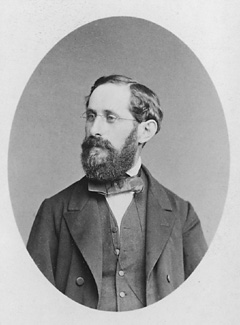Eduard Heine
| Eduard Heine | |
|---|---|

Heinrich Eduard Heine
|
|
| Born |
16 March 1821 Berlin, Prussia |
| Died | 21 October 1881 (aged 60) Halle, Prussia |
| Residence | Prussia |
| Nationality | German |
| Fields | Mathematician |
| Institutions |
University of Bonn University of Halle |
| Alma mater | University of Berlin |
| Doctoral advisor |
Enno Dirksen Martin Ohm |
| Known for | Uniform continuity |
| Influences | Peter Gustav Lejeune Dirichlet |
| Notable awards | Gauss medal |
Heinrich Eduard Heine (16 March 1821, Berlin – October 1881, Halle) was a German mathematician.
Heine became known for results on special functions and in real analysis. In particular, he authored an important treatise on spherical harmonics and Legendre functions (Handbuch der Kugelfunctionen). He also investigated basic hypergeometric series. He introduced the Mehler–Heine formula.
Heinrich Eduard Heine was born on 16 March 1821 in Berlin, as the eighth child of banker Karl Heine and his wife Henriette Märtens. Eduard was initially home schooled, then studied at the Friedrichswerdersche Gymnasium and Köllnische Gymnasium in Berlin. In 1838, after graduating from gymnasium, he enrolled at the University of Berlin, but transferred to the University of Göttingen to attend the mathematics lectures of Carl Friedrich Gauss and Moritz Stern. In 1840 Heine returned to Berlin, where he studied mathematics under Peter Gustav Lejeune Dirichlet, while also attending classes of Jakob Steiner and Johann Franz Encke. In 1842 he was an awarded a Ph.D. by the University of Berlin for a thesis on differential equations submitted with Enno Dirksen and Martin Ohm as advisors. Heine dedicated the doctoral thesis to his professor Gustav Dirichlet. Next he went to the University of Königsberg to participate in the mathematical seminar of Carl Gustav Jacobi, while also following mathematical physics classes of Franz Ernst Neumann. In Königsberg Heine got in contact with fellow students Gustav Kirchhoff and Philipp Ludwig von Seidel.
...
Wikipedia
